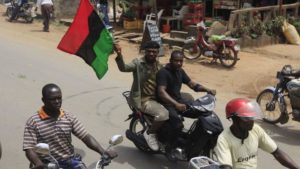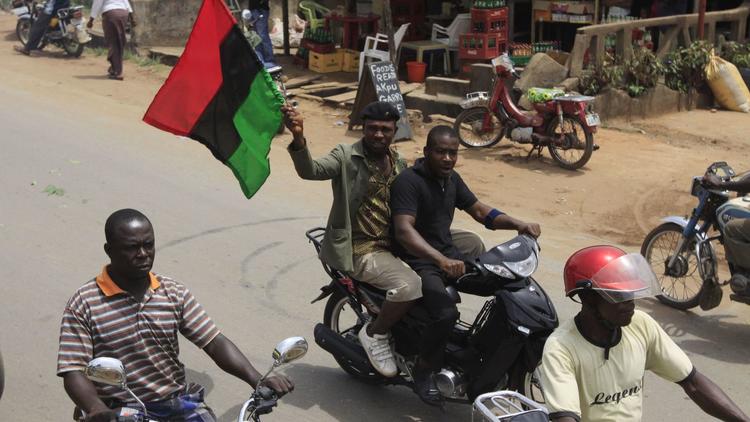 At first, the mood at the demonstration staged on a high school playing field in the city of Aba, Nigeria, was almost festive. Dozens of demonstrators, calling for Biafran independence, waved red, black and green flags, and danced, clapped and chanted. Within hours, the military moved in and opened fire with live bullets.
At first, the mood at the demonstration staged on a high school playing field in the city of Aba, Nigeria, was almost festive. Dozens of demonstrators, calling for Biafran independence, waved red, black and green flags, and danced, clapped and chanted. Within hours, the military moved in and opened fire with live bullets.
The flags toppled and were picked up by soldiers who used the wooden flagpoles to beat protesters who had fallen, as others fled. The scene plays out on a video taken by a witness and offered to the rights group Amnesty International.
The protest on Feb. 9 received little international attention at the time, but a report last week by Amnesty International has cast a spotlight on the incident and an ongoing conflict that has gone largely unnoticed outside Africa.
The region in southeast Nigeria saw a deadly civil war and starvation in 1967 after it declared itself an independent country, Biafra. The government imposed a food blockade, and around 2 million people died, mostly from starvation.
Renewed calls for secession have sprung up in recent years, led by a separatist group, the Indigenous People of Biafra, which emerged in 2012. The pro-Biafra movement involves mainly the Igbo people, a group that long has felt marginalized and neglected by Nigerian governments.
The Amnesty International report, released Thursday, accused Nigerian security forces of a “chilling campaign” of torture and killings to clamp down on a pro-Biafran independence movement. Between August 2015 and August 2016, Nigeria’s military killed at least 150 pro-Biafran protesters, according to the report, warning the actual numbers killed could be much higher.
Nigeria’s military says it acted with restraint and accused the protesters of violence. Military spokesman Sani Usman told Reuters that protesters killed five police officers at a May protest and attacked both military and police vehicles.
The Amnesty International report addresses several incidents but focuses in particular on the Feb. 9 protest at Aba National High School.
“They started shooting us, killing our brothers. Over 10 of them were lying dead there,” wept one young male protester in the video of the protest.
The video also quotes a woman who was at the protest: “People dying. People falling on the ground. Blood gushing out. The whole part of that field was filled with human beings’ blood. Then after awhile, they started carrying dead bodies into their van.”
Four days later, 13 bodies of protesters were found in a shallow pit by the Aba-Port Harcourt highway in Abia state, Amnesty International said.
The organization interviewed 146 eyewitnesses and reviewed 87 videos and 122 photographs in its investigation of the violence and found that police repeatedly fired live ammunition at protesters without warning.
“Eyewitness testimony and video footage of the rallies, marches and meetings demonstrate that the Nigerian military deliberately used deadly force,” according to the report.
In the worst incident at a protest on May 30, in Onitsha, Anambra State, at least 60 pro-Biafran demonstrators were killed when soldiers opened fire on a protest, the report found. Some protesters who took cover in gutters were pursued by soldiers and executed, according to the report.
One protester, a 28-year-old teacher who hid in a gutter, told Amnesty International that he saw the soldiers piling up bodies of those who were shot. He said a soldier found him in a gutter and poured acid on him.
“I covered my face. I would have been blind by now. He poured acid on my hands. My hands and body started burning. The flesh was burning. They dragged me out of the gutter. They said I’ll die slowly.” In a video of an interview with Amnesty International, the man still bears burn scars on his arms.
A 28-year-old woman recounted getting a morning phone call from her husband on May 30, from the scene of the Onitsha demonstration. He told her he had been shot in his stomach and had been thrown on the back of a moving military vehicle with six other people, four of whom were dead.
Then her husband started whispering. He told her the vehicle had just stopped.
“He was scared they would kill the remaining three of them that were alive,” the wife, who has one child, told Amnesty International. “He paused and told me they were coming closer. I heard gunshots, and I did not hear a word from him after that.”
She found his body in the mortuary the next day. He had a gunshot wound to the stomach and two shots in his chest.
The Nigerian military has defended its actions. In June, an army spokesman, H.A. Gambo, said the protesters unleashed anarchy and security forces had “acted responsively in order to de-escalate the deteriorating security scenario.”
Nigerian police and military often have been criticized for killings and rights violations in various parts of the country by international human rights groups, including Amnesty International and Human Rights Watch.
“It is chilling to see how these soldiers gunned down peaceful IPOB members. The video evidence shows that this was a military operation with intent to kill and injure,” said Amnesty International interim director for Nigeria Makmid Kamara.
The IPOB leader, Nnamdi Kanu, who was arrested in December, faces trial for treason, along with other activists.








The demand for Biafra should be more strategic than physical and confrontational. Where is the central think-tank? What signals are the movement’s leaders sending out to their followers? Is there a hierarchy? Does any particular person have the ears of others? Without strategy, people will use their hands and cudgels. I recommend strategy, negotiations, awareness campaigns, mutual trust, and equity among the messengers (not leaders).